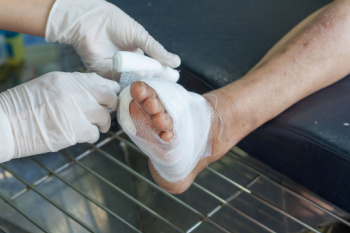
Kevin F Gallagher, DPM
Board Certified in Foot and Ankle Surgery
(724) 941-4330

Kevin F Gallagher, DPM
Board Certified in Foot and Ankle Surgery
(724) 941-4330

When selecting walking shoes, comfort and support are key factors that contribute to foot health. It is important to choose shoes that fit well from the start, as poorly fitting shoes can lead to issues such as plantar fasciitis or Achilles tendinitis. Look for walking shoes with a flexible sole that allows for natural foot movement, and avoid those with overly thick heels that can disrupt your stride. Shopping for shoes later in the day, when your feet are slightly swollen, can help ensure a better fit. Additionally, wearing the socks you plan to walk in while trying on shoes can make a difference in comfort. Remember to leave some space for your toes to move, as tight shoes can lead to blisters and other problems. If you experience foot pain after walking, it is suggested that you schedule an appointment with a podiatrist to see if your footwear is part of the problem.
It is important to find shoes that fit you properly in order to avoid a variety of different foot problems. For more information about treatment, contact Dr. Kevin F. Gallagher from Gallagher Podiatry. Our doctor will treat your foot and ankle needs.
Proper Shoe Fitting
Shoes have many different functions. They cushion our body weight, protect our feet, and allow us to safely play sports. You should always make sure that the shoes you wear fit you properly in order to avoid injuries and deformities such as: bunions, corns, calluses, hammertoes, plantar fasciitis, stress fractures, and more. It is important to note that although a certain pair of shoes might be a great fit for someone else, that doesn’t mean they will be a great fit for you. This is why you should always try on shoes before buying them to make sure they are worth the investment. Typically, shoes need to be replaced ever six months to one year of regular use.
Tips for Proper Shoe Fitting
The shoes you buy should always feel as good as they look. Shoes that fit properly will last longer, feel better, and improve your way of life each day.
If you have any questions, please feel free to contact one of our offices located in McMurray and Hickory, PA . We offer the newest diagnostic and treatment technologies for all your foot care needs.

Ingrown toenails occur when the edge of the toenail grows into the surrounding skin, causing pain, swelling, and sometimes infection. Common causes include improper nail trimming, where nails are cut too short or rounded, leading to the nail growing into the skin. Tight or ill-fitting shoes can also press the toenail into the skin, making the problem worse. Genetic factors and trauma to the toenail, such as stubbing or injury, may contribute to the condition as well. Preventing ingrown toenails involves several strategies. First, trim toenails straight across without rounding the edges, and avoid cutting them too short. Wearing well-fitting shoes with enough toe room can reduce pressure on the toenails. Maintaining good foot hygiene helps prevent infections if an ingrown toenail does occur. If symptoms persist or an infection develops, it's suggested you contact a podiatrist for appropriate treatment and to avoid complications.
Ingrown toenails may initially present themselves as a minor discomfort, but they may progress into an infection in the skin without proper treatment. For more information about ingrown toenails, contact Dr. Kevin F. Gallagher of Gallagher Podiatry. Our doctor can provide the care you need to keep you pain-free and on your feet.
Ingrown Toenails
Ingrown toenails are caused when the corner or side of a toenail grows into the soft flesh surrounding it. They often result in redness, swelling, pain, and in some cases, infection. This condition typically affects the big toe and may recur if it is not treated properly.
Causes
You are more likely to develop an ingrown toenail if you are obese, have diabetes, arthritis, or have any fungal infection in your nails. Additionally, people who have foot or toe deformities are at a higher risk of developing an ingrown toenail.
Symptoms
Some symptoms of ingrown toenails are redness, swelling, and pain. In rare cases, there may be a yellowish drainage coming from the nail.
Treatment
Ignoring an ingrown toenail can have serious complications. Infections of the nail border can progress to a deeper soft-tissue infection, which can then turn into a bone infection. You should always speak with your podiatrist if you suspect you have an ingrown toenail, especially if you have diabetes or poor circulation.
If you have any questions, please feel free to contact one of our offices located in McMurray and Hickory, PA . We offer the newest diagnostic and treatment technologies for all your foot care needs.

A matrixectomy is a surgical procedure that treats severe toenail issues by removing part or all of the nail matrix, the tissue responsible for nail growth. This type of foot surgery is often recommended for persistent toenail conditions like ingrown toenails or fungal infections that do not respond to conservative treatment. A complete matrixectomy involves the removal of the entire nail matrix, which prevents any future nail growth and can be necessary for severe or recurrent conditions. In contrast, a partial matrixectomy removes only a portion of the nail matrix, preserving some nail growth while addressing localized problems. Both approaches aim to alleviate pain and prevent further complications, with the choice between them depending on the specific condition and its severity. If your toenail is causing chronic discomfort and pain, it is strongly suggested that you visit a podiatrist who can determine if this type of foot surgery is right for you.
Foot surgery is sometimes necessary to treat a foot ailment. To learn more, contact Dr. Kevin F. Gallagher of Gallagher Podiatry. Our doctor will assist you with all of your foot and ankle needs.
When Is Surgery Necessary?
Foot and ankle surgery is generally reserved for cases in which less invasive, conservative procedures have failed to alleviate the problem. Some of the cases in which surgery may be necessary include:
What Types of Surgery Are There?
The type of surgery you receive will depend on the nature of the problem you have. Some of the possible surgeries include:
Benefits of Surgery
Although surgery is usually a last resort, it can provide more complete pain relief compared to non-surgical methods and may allow you to finally resume full activity.
Surgical techniques have also become increasingly sophisticated. Techniques like endoscopic surgery allow for smaller incisions and faster recovery times.
If you have any questions please feel free to contact one of our offices located in McMurray and Hickory, PA . We offer the newest diagnostic and treatment technologies for all your foot and ankle needs.

Diabetic foot complications are a significant concern for people with diabetes. Problems arise from peripheral neuropathy, poor circulation, and increased susceptibility to infections. Peripheral neuropathy, affecting up to 70 seventy percent of diabetic patients, leads to loss of sensation in the feet. This makes injuries and infections more likely to go unnoticed and untreated. Poor blood circulation due to damaged blood vessels makes the situation worse by impeding the healing process. This contributes to the development of non-healing ulcers and, in severe cases, gangrene. Complications from diabetes result in serious outcomes in up to a quarter of diabetic patients, and, alarmingly, contribute to approximately 70 percent of leg amputations in diabetics patients. Comprehensive foot care programs have shown to significantly decrease amputation rates. A podiatrist can provide early diagnosis and intervention, manage infections, and recommend proper footwear to prevent injuries. If you are suffering from foot problems due to diabetes, it is suggested that you make a podiatrist a part of your medical team and schedule regular checkups of your feet.
Diabetic foot care is important in preventing foot ailments such as ulcers. If you are suffering from diabetes or have any other concerns about your feet, contact Dr. Kevin F. Gallagher from Gallagher Podiatry. Our doctor can provide the care you need to keep you pain-free and on your feet.
Diabetic Foot Care
Diabetes affects millions of people every year. The condition can damage blood vessels in many parts of the body, especially the feet. Because of this, taking care of your feet is essential if you have diabetes, and having a podiatrist help monitor your foot health is highly recommended.
The Importance of Caring for Your Feet
Patients with diabetes should have their doctor monitor their blood levels, as blood sugar levels play such a huge role in diabetic care. Monitoring these levels on a regular basis is highly advised.
It is always best to inform your healthcare professional of any concerns you may have regarding your feet, especially for diabetic patients. Early treatment and routine foot examinations are keys to maintaining proper health, especially because severe complications can arise if proper treatment is not applied.
If you have any questions please feel free to contact one of our offices located in McMurray and Hickory, PA . We offer the newest diagnostic and treatment technologies for all your foot and ankle needs.